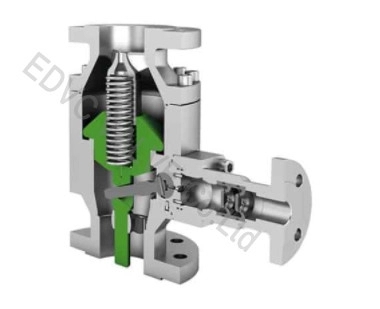GALLERY
 |  |
PRODUCT DESCRIPTION
The ARC Automatic Recirculation Valve
It is an inconspicuous element in the pump circuit. Yet – like a fuse in a power circuit – it is essential for the safety of a plant. In addition, given its operating principle, it makes a valuable contribution to energy efficiency.

Most centrifugal pumps operate with a constant speed along a fixed curve.
The pumps are integrated into plants with variable discharge flows. The variable flows lead to working areas where process-related flow rates are below the required pump specific minimum flow.
The pump minimum continuous flow (MCF) is the lowest permitted flow rate that the centrifugal pump can handle permanently without damage, as well as ensuring safe and economic operation.
To ensure the required flow rate does not fall below the permissible minimum, it is common to install a bypass with orifice between the pump’s discharge branch and the first shut-off device in the pressure line.
The orifice device permanently allows the constant minimum flow to pass to the tank or to the suction line. The orifice solution permits a constant loss of flow rate that considerably reduces the efficiency of the pump assembly.
Based on economic and ecological aspects, this solution is only acceptable for smaller low pressure pumps with low minimum flows.
A good solution for large plants and high pressures
For assemblies with larger pumps and higher operating pressures, the following solutions are applied:
Systems with an actuated control valve, with flap valve and according measurement technology
The automatic recirculation check (ARC) valve which practically includes all the above-mentioned functions of an actuated control valve
Systems with actuated control valves are relatively complex and expensive, while solutions that incorporate an automatic recirculation check valve are considerably simpler and more robust.
Operating principle
Automatic recirculation check valves are mounted on the discharge branch of the pump or in the pressure line right after the pump. The bypass branch of the valve is connected to the bypass line.
The valve operates on demand flow. In start-up conditions with no demand flow to process, the valve will allow the MCF through the bypass.
As the process demand is opened, the valve will modulate flow between the process and bypass branch. As the process demand exceeds the MCF, the bypass will fully close and all flow through the valve is sent to process.
If the actual process flow rate falls below the required minimum flow, the valve automatically opens the bypass line and the determined flow rate can be discharged through the bypass.
The ARC valve ensures that the entire pump flow rate (process flow plus bypass flow) is always greater than the required minimum flow.
In this scenario, the pump is always protected from low flow conditions. ARC valves consist of a three-way body with three integrated flange connections that are the interfaces to the pump assembly.
Internally there is a guided and spring-loaded valve cone which provides the check function and prevents backflow of the medium through the pump.
The stroke of the check valve is reliable and mechanically operates the bypass lever. The operation of the bypass lever regulates the opening and closing of the bypass branch and consequently the bypass flow.
Compared to the operating pump pressure level, the pressure level in the bypass line is considerably lower (since the bypass line either leads to the tank or the suction line).
The bypass of the valve provides an additional feature of pressure reduction in the bypass line. This pressure reduction feature prevents flashing and cavitation in the bypass line and return tank.
Principle of ARC:

Advantages and applications
Process fluid controlled and they do not require any external energy source
Highly reliable, robust and low maintenance
Bypass flow rates are regulated at a permanent minimum and the pump assembly is protected safely
Pump head losses are minimised – the pump assembly’s efficiency remains high keeping operating costs low
Applicable for almost all liquid mediums where centrifugal pumps are used. The temperature range extends from minus 273°C up to plus 400°C
Made from materials ranging from carbon steels to super duplex steels according to technical or customer requirements. The interior parts are made from stainless steel
Simple design and plant-specific installation conditions (i.e. piping connections) are often considered
All Schroeder ARC valves undergo flow testing after manufacturing to simulate the pump design conditions the valves are designed to protect


Leave your message